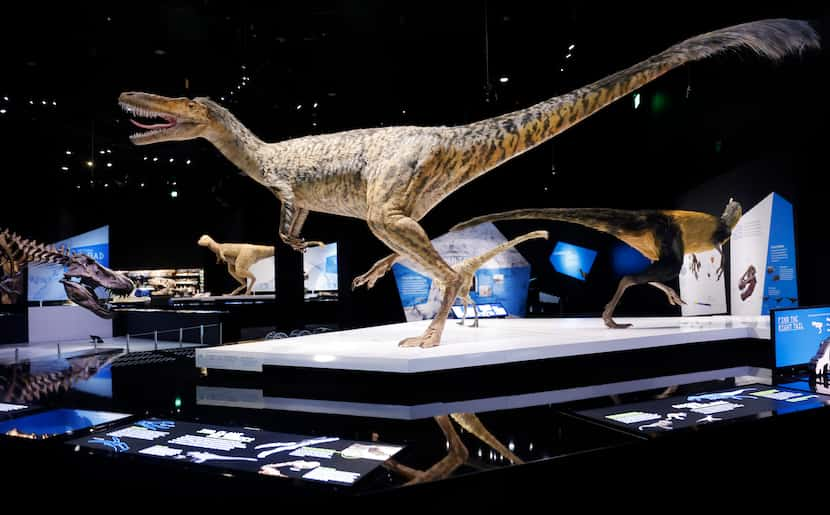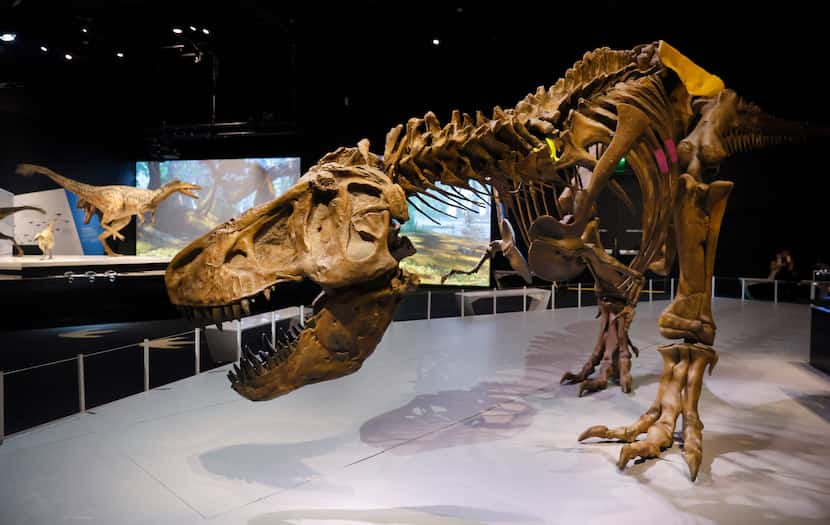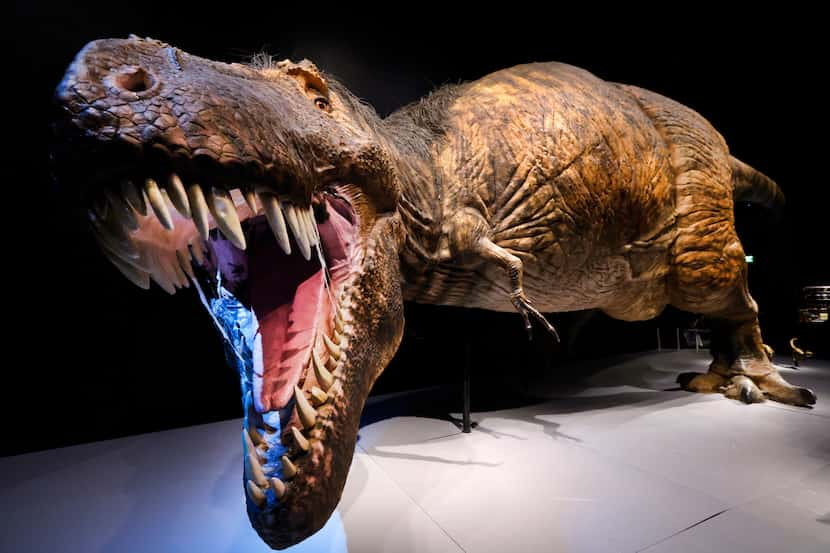When the first Tyrannosaurus rex skeleton was put up in New York’s American Museum of Natural History in the early 1900s, crowds lined up for blocks. The tyrant lizard king — a hulking, meat-eating dinosaur with a gaping mouth and tiny arms — towered over visitors.
“It just got ingrained into the imagination of the mind, the culture, and never surrendered that spot,” said Ron Tykoski, vice president of science at the Perot Museum of Nature and Science.
The Perot Museum’s latest exhibition, “T. rex: The Ultimate Predator,” explores the evolution of the fearsome hunter. On loan from the American Museum of Natural History, the exhibition runs Nov. 13 to Sept. 22, 2024.
Several members of the Tyrannosaur family roamed Dallas-Fort Worth some 96 million years ago, and leg bones from a Tyrannosaur discovered at Big Bend National Park are on display on the Perot Museum’s fourth floor. The museum’s CEO, Linda Silver, said the exhibit uses interactive displays and models to illuminate how T. rex may have lived.
“It has everything from an estimated nine-ton T. rex adult, fully carved out in sculptural form,” she said, “as well as … these little hatchlings, the baby T. rexes, that are so pathetically ugly, they’re cute.”
From chick to chomper
A fuzzy T. rex chick, about the size of a turkey, is the first model visitors encounter.

“And then you wind your way through the exhibit, as this thing grows up and becomes less cute,” Tykoski said.
T. rexes grew to become 40-foot-long giants, though Tykoski notes they were likely too heavy to keep up with that Jeep in Jurassic Park.
In one interactive display, a life-size T. rex animation stalks visitors as if they were prey. In another, visitors can mix sound effects to imagine what T. rex’s roar may have sounded like.
Also featured in the exhibit are T. rex bones and teeth and casts of fossilized poop.
The exhibit also introduces visitors to T. rex’s family tree. Some of the earliest Tyrannosaurs 170 million years ago were “little runts” the size of coyotes or wolves, Tykoski said, hiding from larger meat-eating dinosaurs. Members of the Tyrannosaur family evolved over time until the T. rex — the last and largest of them — claimed top dog.

T. rex appeared about 67 million years ago, Tykoski said, and the asteroid that wiped out the dinosaurs came around 1 million years later.
“So the Tyrannosaurus rex actually only existed for a very short period of time, geologically speaking.”
Dino research in Dallas
Scientists’ understanding of how T. rex lived is still evolving. The information in the exhibition is scientifically up to date, Tykoski said, but researchers are constantly coming out with new ideas. One debated finding from a study published earlier this year suggests T. rex may have had lips covering its teeth.
Silver said she hopes the exhibition will show visitors that science is dynamic, changing over time as researchers discover new evidence. The Perot Museum has its own staff of paleontologists, and visitors can watch them work at the Paleo Lab on the museum’s fourth floor.

Perot scientists recently named a newly-discovered plant-eating dinosaur, and in 2014, Tykoski and the museum’s former chief curator, Anthony Fiorillo, announced the discovery of a pygmy Tyrannosaur called Nanuqsaurus hoglundi that lived in the Arctic.
“They’re still working on these creatures,” said Silver, “because there’s still so much to learn.”
AT A GLANCE
WHERE The Perot Museum of Nature and Science, 2201 N. Field St., Dallas, TX 75201
WHEN The exhibit continues through Sept. 22, 2024.
PRICE Admission to the Perot Museum is $25 for adults and $15 for youth (2-12). “T. Rex: The Ultimate Predator” requires an additional ticket of $8 for adults and $7 for youth. Children under 2 enter for free. For museum members, general admission is free and for museum Explore members, a “T. Rex: The Ultimate Predator” ticket is $6.
Adithi Ramakrishnan is a science reporting fellow at The Dallas Morning News. Her fellowship is supported by the University of Texas at Dallas. The News makes all editorial decisions.


/cloudfront-us-east-1.images.arcpublishing.com/dmn/FAACMFKVTJAVXPS2K2YL2ZEL54.jpg)
:no_upscale()/cloudfront-us-east-1.images.arcpublishing.com/dmn/UFOGSORT65ACPP7MPIZSWIQRQY.jpg)
/cloudfront-us-east-1.images.arcpublishing.com/dmn/YPSJN4T7UVFRTJQ7LFIP2JHPQI.jpg)
/cloudfront-us-east-1.images.arcpublishing.com/dmn/5GJ5JZB46JAHLKVSSGC3NMVOUA.jpg)
/cloudfront-us-east-1.images.arcpublishing.com/dmn/JVS7U4WOINECDFHFVXD7BMSKE4.jpg)